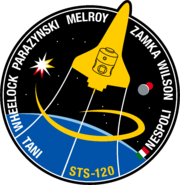
Space Shuttle Atlantis will deliver the U.S. Harmony module, and will
reconfigure part of the station to prepare for future assembly missions.
STS-120
STS-120 (englisch Space Transportation System)
ist eine Missionsbezeichnung für den US-amerikanischen Space Shuttle
Atlantis (OV-104) der NASA.
Der Start ist momentan für den 26. August 2007 von der Startrampe 39A
vorgesehen.

STS-120 Mission Patch
The STS-120 crew, led by commander Pam Melroy, will wear a black,
blue and gold mission patch that features their primary payload and that
appears to draw from the Astronaut Office symbol for its design. The
circular badge is ringed by the seven names of the crew, including an
Italian flag next to European Space Agency astronaut Paolo Nespoli's
name. The insignia displays a shuttle orbiter with the embedded outline of
the Node 2 multi-port module. The constellation Orion appears to be rising
over Earth's horizon, below the Moon and Mars. A sunburst balances the
patch, opposite the planets. A stylized vector gold completes the insignia.
STS-120 Overview
STS-120 is the 23rd shuttle mission to the International Space Station, and
will launch an Italian-built U.S. multi-port module for the station.
Air Force Col. Pamela A. Melroy will command the STS-120 mission to
take the Node 2 connecting module to the station. Melroy, a veteran
shuttle pilot, is the second woman to command a shuttle. Marine Corps
Col. George D. Zamka will serve as pilot. The flight's mission specialists
will be Scott E. Parazynski, Army Col. Douglas H. Wheelock, Stephanie D.
Wilson and Paolo A. Nespoli, a European Space Agency astronaut from
Italy. Zamka, Wheelock and Nespoli will be making their first spaceflight.
Expedition 15 Flight Engineer Clayton Anderson will return to Earth from
the space station aboard shuttle mission STS-120. That flight will carry his
replacement, Daniel Tani, to the station. Tani will return on shuttle mission
STS-122.
Mission: STS-120 - 23rd International Space Station Flight (10A) -
U.S. Node 2 "Harmony" module
Vehicle: Atlantis (OV-104)
Location: Vehicle Assembly Building High Bay 1 (in preparation for STS-117)
Launch Date: Targeted for August 26, 2007
Launch Pad: 39A
Crew: Pamela Melroy, George Zamka, Stephanie Wilson, Scott
Parazynski, Douglas Wheelock, Paolo Nespoli and Daniel Tani
Inclination/Orbit Altitude: 51.6 degrees/122 nautical miles
Shuttle Flight: No. 120
Atlantis Flight: No. 29
Shuttle-ISS Flight: No. 23
NASA Space Station Module In
Perfect ‘Harmony’ With New Name
14 March 2007
Ever since it was designed and built for the International Space Station, it
has been known as the Node 2 module. Now thanks to students from
across the United States, Node 2 also will be known as Harmony.
The name was chosen from an academic competition involving more than
2,200 students in kindergarten through high school from 32 states. The
Node 2 Challenge required students to learn about the space station, build
a scale model and write an essay explaining their proposed name for the
module that will serve as a central hub for science labs.

Computer-generated artist's rendering of the International Space
Station after the Harmony connecting node (circled in yellow) is relocated
from the Unity node port side to the forward port of the Destiny
Laboratory. Credit: NASA
Six different schools submitted Harmony. A panel of NASA educators,
engineers, scientists and senior agency management selected it because
the name symbolizes the spirit of international cooperation embodied by
the space station, as well as the specific role played by the module in tying
together the international partner modules.
Quelle: NASA.gov
Die Bedeutung des Verbindungsmoduls
"Harmony" (Node 2)
Das folgende Bild zeigt die Internationale Raumstation nach Fertigstellung
im Jahr 2010. Sowohl das europäische Modul "Columbus", als auch das
japanische Modul "Kibo" werden an "Harmony" (Node 2) montiert.

Next: The STS-120 Crew
NASA TV
STS-120
Harmony (ISS)
NASA - Harmony Node 2






































































Kommentar